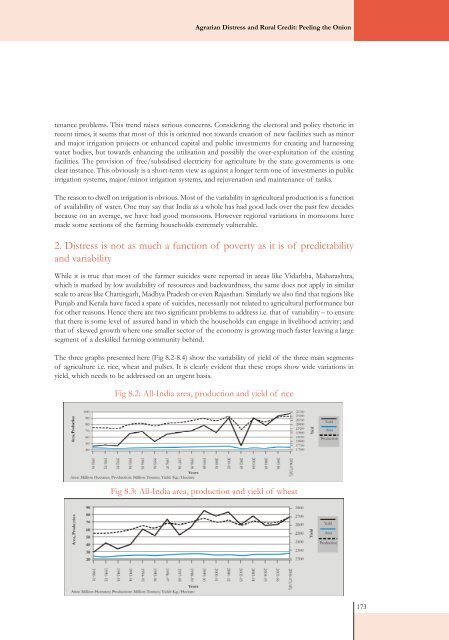SOIL Report 2008 - ACCESS Development Services
SOIL Report 2008 - ACCESS Development Services
SOIL Report 2008 - ACCESS Development Services
Create successful ePaper yourself
Turn your PDF publications into a flip-book with our unique Google optimized e-Paper software.
Agrarian Distress and Rural Credit: Peeling the Oniontenance problems. This trend raises serious concerns. Considering the electoral and policy rhetoric inrecent times, it seems that most of this is oriented not towards creation of new facilities such as minorand major irrigation projects or enhanced capital and public investments for creating and harnessingwater bodies, but towards enhancing the utilisation and possibly the over-exploitation of the existingfacilities. The provision of free/subsidised electricity for agriculture by the state governments is oneclear instance. This obviously is a short-term view as against a longer term one of investments in publicirrigation systems, major/minor irrigation systems, and rejuvenation and maintenance of tanks.The reason to dwell on irrigation is obvious. Most of the variability in agricultural production is a functionof availability of water. One may say that India as a whole has had good luck over the past few decadesbecause on an average, we have had good monsoons. However regional variations in monsoons havemade some sections of the farming households extremely vulnerable.2. Distress is not as much a function of poverty as it is of predictabilityand variabilityWhile it is true that most of the farmer suicides were reported in areas like Vidarbha, Maharashtra,which is marked by low availability of resources and backwardness, the same does not apply in similarscale to areas like Chattisgarh, Madhya Pradesh or even Rajasthan. Similarly we also find that regions likePunjab and Kerala have faced a spate of suicides, necessarily not related to agricultural performance butfor other reasons. Hence there are two significant problems to address i.e. that of variability – to ensurethat there is some level of assured band in which the households can engage in livelihood activity; andthat of skewed growth where one smaller sector of the economy is growing much faster leaving a largesegment of a deskilled farming community behind.The three graphs presented here (Fig 8.2-8.4) show the variability of yield of the three main segmentsof agriculture i.e. rice, wheat and pulses. It is clearly evident that these crops show wide variations inyield, which needs to be addressed on an urgent basis.Fig 8.2: All-India area, production and yield of riceFig 8.3: All-India area, production and yield of wheat173














